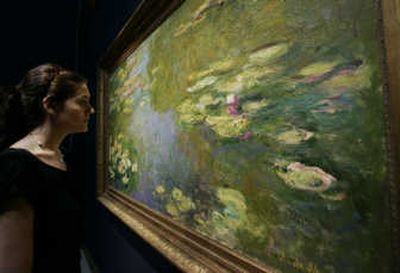A rich palette of green

Art collectors set a sales record during the summer auctions that concluded Wednesday in London. Yet buyers largely played it safe, making classic bets like Bacon and Monet over newer artists whose prices could suffer more in an art-market slowdown.
The world’s two chief auction houses — Sotheby’s and Christie’s International PLC — brought in just over $1 billion combined during the past two weeks, up 19 percent from $879 million at similar sales last June and $588 million the year before. Smaller auction house Phillips de Pury & Co. also sold $61 million during London’s twice-a-year sale of major contemporary, modern and Impressionist art.
The sales come at an erratic time for the art market. Buyer confidence dropped sharply last fall amid economic woes in the broader financial markets, which put a damper on New York’s major art sales in May. But those May sales nevertheless logged a handful of blockbuster prices — including an $86 million Francis Bacon at Sotheby’s — that have since served to restore a measure of optimism to the art marketplace, according to ArtTactic, a London-based firm that analyzes auction sales.
“The market is still healthy for great, dead artists, but there are problems bubbling up for living artists,” says Monte Carlo dealer David Nahmad. “Collectors are just being careful.” Still, overall sales set a record, underscoring London’s resurgence as a global art hub to rival New York.
Christie’s won this latest round over Sotheby’s by selling $548 million worth of art, well within its pre-sale estimate of between $433 million to $612 million. The star of Christie’s sale was Claude Monet’s avocado-green view of a water-lily pond, “Le bassin aux nympheas,” which sold to London art adviser Tania Buckrell Pos for $80.5 million, over its $48 million high estimate.
Sotheby’s brought in $497 million, which also fell within its $357 million to $511 million estimate. Its top lot was a rare Gino Severini view of a dancer, “Danseuse,” a Creamsicle-colored Futurist work that sold for $29.6 million, surpassing its $20 million high estimate and breaking the artist’s record seven-fold.
Behind the scenes, both major auction houses are hustling to find art to suit two diverging audiences. A handful of new Russian and Middle Eastern buyers, flush from a commodities boom, are willing to pay high prices for trophy paintings, yet the majority of collectors and art investors are beginning to cut back and avoid artworks of middling quality. In the long run, this splintering phenomenon could push up prices for an elite group of artists but undercut the overall health of the art market. In past boom-and-bust cycles, art experts say, the middle and the top ends of the art market have risen and fallen in sync.
Jussi Pylkkanen, president of Christie’s Europe, says he isn’t worried about this growing gap in buyers’ budgets because overall sales totals keep climbing, but he adds, “The key thing for us will be to distinguish between what’s great art and what’s just good and price them accordingly.”
In London, buyers hedged their bets by seeking out older works with impressive ownership histories or track records. Both Christie’s and Sotheby’s exceeded their high estimates for their evening sales of Impressionist and modern art, with Christie’s bringing in $284 million and Sotheby’s bringing in $201 million. Besides the Monet, Christie’s sold Edgar Degas’s elegant view of two ballerinas, “Danseuses a la barre,” for $26 million and Natalia Goncharova’s swirling 1912 still life, “Les fleurs,” for a record $10.8 million.
Sotheby’s sold all but five of its 55 works on offer at its Impressionist evening sale, highlighted by the Severini but also by Alberto Giacometti’s 1948 bronze depicting three pencil-thin figures, “Trois hommes qui marchent I,” which doubled its estimate by selling to an anonymous buyer for $18.5 million. Buyers have also begun to favor bright, jewel-toned paintings over monochromatic ones, a shifting aesthetic that is buoying prices for European avant-garde artists like Chaim Soutine and Wassily Kandinsky, says Helena Newman, Sotheby’s vice-chair of Impressionist and Modern art world-wide.